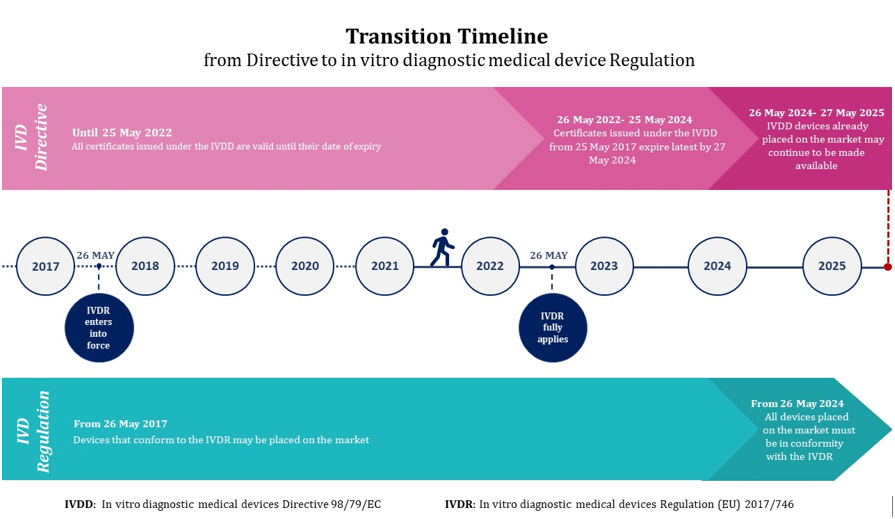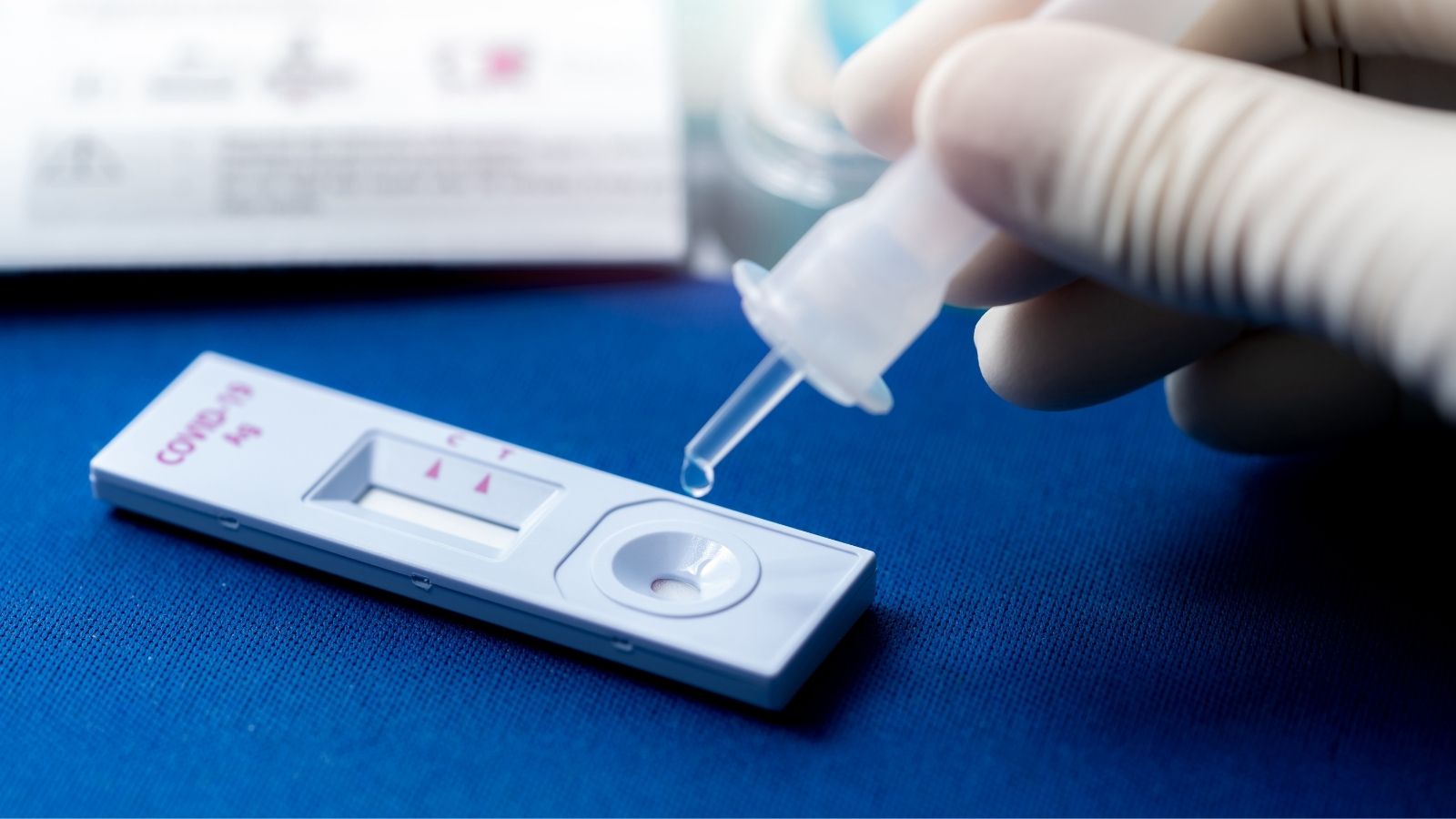In vitro diagnostic (IVD) medical devices (Manufacturers | Internal Market, Industry, Entrepreneurship and SMEs (europa.eu)) have gained a lot of attention in the past decennia.
The corona crisis has taught us that rapid and correct diagnosis, which requires IVD medical devices, is an essential part of the global healthcare system. From relatively simple self-tests in pregnancy to complex state-of-the-art laboratory diagnostics, IVDs cover a wide range of equipment and tests.
With this upward trend in the IVD market, new and strict regulations were introduced in order to ensure high quality, strong performance, and safety for all.
Prior to 2017, the IVD Directive (IVDD) set the regulatory requirements for CE marking. This directive was expanded to the IVD Regulation (IVDR), which introduced a harmonized regulation in Europe with stricter rules to market IVDs. The IVDR was published in May 2017 and will be fully enforced in May 2022.
This blog will navigate you through the key changes and pitfalls that IVD manufacturers will face before the full implementation of the IVDR.
How to bring an IVD to the market under the new IVDR (Regulation (EU) 2017/746)
Regulation (EU) 2017/746 (L_2017117EN.01017601.xml (europa.eu)) of the European Union (IVDR) has been the regulation specifically for IVD medical devices since 2017 and will fully replace the repealing IVDD Directive 98/79/EC in 2022. There have been no changes to the IVDR from the IVDD, but new requirements have been added that include:
- changes in device classification
- stricter oversight of manufacturers by Notified Bodies
- tightened requirements for clinical evidence and conformity assessment
- common specifications
In contrast to the IVDD, the IVDR does not need to be transposed into national law, which reduces the risks of discrepancies in interpretation across the EU market.
An important addition of the IVDR was the introduction of 4 IVD medical device risk classes, from low to high risk: A, B, C, and D. More information about this newly introduced risk classification can be found here.
IVDs where general life-threatening conditions apply can be accounted as the highest risk class D and need a more extensive review to achieve their European certification, which will be explained further.
The application of the IVDR is not straightforward, and the specifications can be more difficult for inexperienced personnel to interpret. Different assessment procedures are required depending on the risk class of the device, and, for medicinal products, the competent authorities must be consulted.
IVDR: 3 common pitfalls along the road
1. Increased involvement of Notified Bodies
Under the IVDD, 90% of IVD medical devices could be self-certified. Under the new IVDR, 85% of devices will require a Notified Body to obtain CE marking. Only Class A non-sterile devices can still be self-certified. A Notified Body is an organization designated by a competent authority of an EU Member State that performs conformity assessments to verify that a product may be placed on the market.
All products previously allowed on the market will have to be reclassified and reregistered, which will introduce a huge regulatory overhead. It takes approximately 12 months to complete a dossier under the IVDD and to achieve a CE-marking for high-risk IVDs. The IVDR increases the workload before market authorization, which further increases this application time.
Only a limited number of notified bodies meet the more stringent IVDR requirements and are therefore available now. With the end of the transition period in sight, it will only become harder to achieve your CE marking on time. Having experts with the necessary knowledge and connections will be crucial to guide you through this process.
2. Innovative, high-risk IVD medical devices require an expert panel review
Even more stringent requirements are in place for the highest-risk devices. These Class D devices are used to detect agents which contain a high individual or public risk. They are used for the detection of transmissible agents in blood, cells or tissue or for the detection of transmissible agents that cause a life-threatening disease like Ebola or malaria.
The medical device coordination group (MDCG) is responsible for a harmonized implementation of the IVDR. They have introduced a mandatory recommendation for the highest risk class (D) devices where the Notified Body needs to check with an individual expert panel to verify the performance claimed by the manufacturer. Tests need to be executed in EU reference laboratories.
Not every high-risk device needs to go through this procedure, only when the device is the first of its kind. This should be interpreted as follows: no common specifications have yet been published in the EU Official Journal and no certificate under the IVDD or IVDR has yet been granted for such a device. The criteria used to determine if an IVD device is the first of its kind are based on two principles. Either the intended purpose or the analysis technology is new to the market.
3. The transition period: time is running out
We are currently in the midst of a transition period from the IVDD to the IVDR to implement these strict rules. The full timeline for the transition is detailed in the figure below.
Manufacturers will have to fully comply with the IVDR on the 26th of May 2022. It is highly recommended to start the transition as soon as possible due to a high number of devices anticipated on the market and the expected bottleneck in reviews by the limited number of Notified Bodies. The pressure on these Notified Bodies will only increase as the deadline draws nearer.

Figure 1 – IVDD to IVDR transition timeline
ADDENDUM OCT 14TH
On October 14, 2021, the European Commission proposed a gradual rollout of the new In Vitro Diagnostic Medical Devices Regulation to avoid disruption in the supply of these essential health products.
The proposal does not involve a substantive change to the requirements of the regulation on in vitro diagnostic (IVD) medical devices, but only modifies the transitional provisions to allow for the gradual rollout of the regulation.
The length of the proposed transition periods depends on the type of device: higher-risk devices, such as HIV or hepatitis tests (Class D) and certain influenza tests (Class C), will have a transition period until May 2025 and 2026, while lower-risk devices, such as Class B and A sterile devices, will have a transition period until May 2027.
IVDR is knocking at the door, get your CE-marking now!
The new IVDR not only introduces a new classification system for devices, but also sets stricter standards for the quality of these IVD medical devices.
Especially for the most innovative and high-risk IVD medical devices, an extra effort will be required to bring your product to market. As the deadline approaches, consultants, in-house professionals and Notified Bodies will all be busier, so act now to be ready in time!
Still a lot of questions about CE marking, IVDD, and IVDR, or put off by these pitfalls? Marketing a new IVD and don’t know where to start? QbD’s help is just an e-mail or phone call away. Our in-house experts will be happy to guide you along the way.
